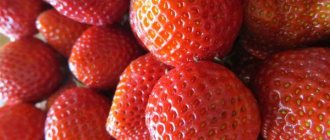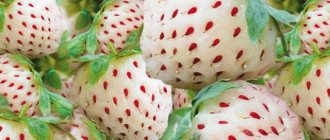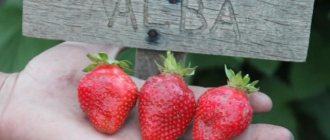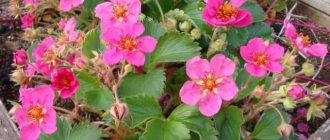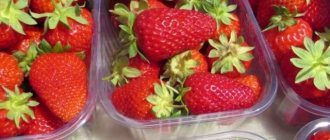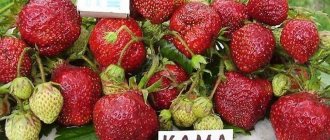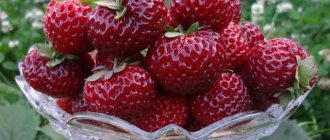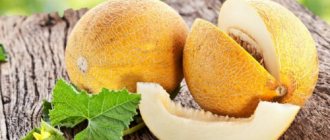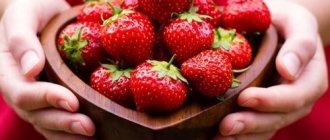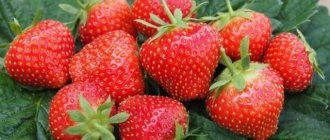Strawberry varieties bred by foreign breeders are not always ready to take root in Russia due to the strong difference in weather conditions. The most valuable are “foreigners” that have stood the test of time and are capable of successfully bearing fruit and wintering not only in the Krasnodar region, but also in the Moscow region, the Urals and Siberia. One of these varieties is the Korona strawberry, a Dutch variety with which Russian gardeners have been familiar for many years.
Strawberry Crown: description of the Dutch variety
In recent decades, Russian gardeners have been trying to grow strawberry varieties of Dutch selection in their gardens. The main motives of summer residents are the following: the high yield of such strawberries, powerful bushes, high resistance to disease.
However, due to differences in climatic conditions, not all varieties of “Dutch” strawberries survive in many Russian regions. But there are also pleasant surprises - for example, the Korona strawberry takes root well and bears fruit in Russia. The main characteristics of this variety, agricultural cultivation techniques, pros and cons will be discussed below.
The content of the article:
1. History of breeding of the variety 2. Characteristics and description of the variety 3. Productivity of the strawberry variety Korona 4. Diseases and pests 5. Agrotechnics of cultivation 6. Preparing strawberries Korona for the winter season 7. Feeding rules 8. Advantages and disadvantages 9. Reviews of strawberries Korona
Description of the plant
The bush is compact, small in size.
- The bush is small, low, open.
- The bushes are compact and do not require much space.
- The leaves are large and concave, with a glossy coating.
- The peduncles are thick and powerful, about 25 cm long, and support the berries by weight. The berries do not come into contact with the ground, remaining dry, and are less susceptible to gray rot.
- Many peduncles, multi-flowered, small flowers.
- The plant is frost-resistant, can withstand temperatures up to 20 degrees below zero. At lower temperatures, be sure to cover with any covering material.
- The Korona variety is considered mid-early, the first fruits appear in mid-June.
- It bears fruit for a long time.
History of variety development
This variety was bred by breeders from the Netherlands several decades ago - in 1972.
However, this berry plant is still popular among gardeners in many countries. And this suggests that Korona strawberries are not inferior in their characteristics to newer varieties and hybrids.
The varieties taken as the basis for the development of Corona strawberries are Tamella and Induka.
From its “parents” the new variety has taken on high resistance to frost and can withstand temperatures down to -20-22 degrees Celsius.
Photo of strawberry Corona
Therefore, in Russia it can be planted in most regions, covered for the winter in areas with harsh winters, or grown in heated greenhouses or greenhouses.
Cultivation care
Subsequent care for garden strawberries consists of fertilizing, watering and loosening the soil to a depth of 7–8 cm when a crust forms.
Table: fertilizer application scheme
| Application time | Amount of feeding |
| After the leaves bloom | 1 tbsp. l. urea per 10 liters of water, 0.5 liters per plant. |
| Before flowering | 1 tsp. potassium sulfate + 2 tbsp. l. Effecton drug per 10 liters of water, 0.5 liters per bush. |
| After fruiting until August 10 | 1 tsp. Agricol products + 1 tbsp. l. nitrophoska per 10 liters of water, consumption 1 liter per plant. |
Watering
During the flowering period, the plant is watered at the rate of 20 liters per 1 m2, after - 10 liters per 1 m2. Garden strawberries are watered between rows along the furrows. Avoid getting moisture on the fruits and leaves. Watering is done in the morning. The optimal water temperature is 20–25 °C. When watering, you need to take weather conditions into account. In case of precipitation, the procedure is postponed until the soil dries. The lack of moisture can be determined by external changes. The leaves of the garden plant wither, the petioles and berries dry out. After watering, the soil between the rows is mulched with sawdust, peat, straw or manure.
Important! For irrigation, you cannot use water with a temperature below 16 ° C, as this provokes the development of gray rot.
Shelter for the winter
The shelter allows the crop to comfortably overwinter in the most severe frosts
If in the area where the Korona variety is grown, in winter the temperature drops below -22 ° C, the crop must be covered with spruce branches, pine needles or special material, for example, agrotex. You should not use hay or straw for this purpose, in which moisture accumulates and also breeds mice. Agrotex allows air, light, moisture to pass through, softens temperature fluctuations and is not of interest to rodents.
Strawberry Crown: characteristics and description of the variety
This variety of strawberries has a mid-early berry ripening period - the mass harvest of ripe fruits is carried out in the second ten days of June. Moreover, the ripening of strawberries is slightly extended - they are usually harvested within 10-15 days.
Important!
The strawberry variety Korona is not remontant.
The bushes are of medium height, but powerful and quite spreading. The foliage is strong, large, shiny, dark emerald. The formation of tendrils is average, so you can safely propagate Corona strawberries only by tendrils, but some gardeners use bush division and seed propagation.
Photo of strawberry bushes Corona
The shape of ripe berries is cone-shaped or heart-shaped. The surface is smooth, even with slightly pressed seeds. The color of the fruit is bright red, almost burgundy. Their weight is 20-25 g. The taste of ripe berries is sweet and juicy, the pulp is quite dense with a characteristic strawberry aroma.
The marketability of the fruits is excellent; it is noted that most of the ripening fruits are the same in size and weight. The fruits are quite delicate, so they do not tolerate transportation well and are not stored for a long time - it is better to process them immediately after picking. The berries can be eaten fresh and used to make compotes and jam.
It is noted that this strawberry variety is resistant to spotted mosaic and is practically not affected by pests and their larvae.
How are wild strawberries different from strawberries?
Garden strawberries are often mistaken for strawberries. These plants do have external similarities, and also belong to the same genus Strawberry and the common Rosaceae family. But they differ from each other:
- Strawberry stems grow up to 25–35 cm, the flowers of this crop are unisexual. And the leaves of the crop are painted light green, clearly corrugated along the edges. The strawberries themselves are medium in size, dark scarlet in color and have a slightly rounded tip.
- Garden strawberries are somewhat larger in size than strawberries, and are also ahead of them in terms of productivity, since they have male and female flowers. The shoots of this plant reach 20–25 cm, and the leaf blades are dark green. The berries have a bright red hue and pointed tips.
Left - strawberries, right - strawberries
Productivity of strawberry variety Korona
Due to its fairly high resistance to cold, Korona strawberries are grown in most Russian regions, but in areas with very frosty winters it is recommended to plant them in greenhouse conditions to protect them from freezing.
The productivity of the Korona strawberry variety is high - at least 1 kg of ripe berries are harvested from each bush with proper agricultural technology. In one place, this variety shows good fruiting for 4-5 seasons, after which the bushes should be transplanted to another place.
Landing rules
The place for strawberry beds should be well lit and protected from constant winds. In winter there should be enough snow here so that the berry bushes can survive without damage. Without winter snow protection, strawberries may grow small and irregular in shape.
Preparing the beds
It is better to prepare the beds in advance. They need to be located from south to north, optimally with an inclination to the southwest. There are many planting methods; each gardener chooses the one that best suits local conditions.
In the southern regions, it is best to plant strawberries in trenches 25–30 cm wide and 25–30 cm deep. They should be filled with humus, ash and bone meal added at 100–150 grams per meter of trench, covered with excavated soil, watered and covered with film. This planting method allows you to retain moisture in the soil and prevents the roots from drying out.
The trench method of planting strawberries maximizes moisture conservation
In the central regions there is less heat and more moisture. Therefore, strawberries are planted on ridges, using the soil between the rows. For every meter of prepared bed, the width of which is 80–100 cm, you need to add a bucket of humus, half a bucket of sand, and a liter jar of stove ash. Dig carefully and form ridges 10–20 cm high.
It is useful to edge the ridges with boards or slate. The distance between the ridges is 80–100 cm.
Strawberries are planted on such elevated ridges in the central regions
To shade the roots, it is useful to plant several bushes of tall marigolds to the south of the strawberry bed, which will both slightly shade the strawberries and repel pests with their smell.
The best predecessors for garden strawberries are onions, garlic, and legumes. At the end of summer, after harvesting onions or garlic, it is good to sow the bed intended for strawberries with white mustard, which will destroy the nematode. Cut off the grown mustard with a flat cutter, mix with the top layer of soil, cover the bed with black non-woven material and leave until the strawberries are planted.
White mustard sown on the site of the future strawberry bed will protect the berry bushes from nematodes
Photo gallery: shape of beds and planting methods
This is what a typical garden strawberry bed looks like
Strawberries in an edged bed under an agrospan have no problems with watering or weeds
Strawberries planted on agrofibre are free from weeds
Sloping bed for strawberries is original and economical
A pyramidal strawberry bed significantly saves land area
A compact pyramid bed, in addition to saving land, may well become a decoration for the garden
Landing dates
Depending on the region, strawberries can be planted from spring to the end of August. The timing depends on the weather and the condition of the seedlings. Most often, planting is done after fruiting has ended: from late July to early September, so that the plants can take root before the onset of cold weather.
How to plant strawberries Corona
Experts usually recommend the following sequence of operations when planting strawberries:
- Mark the bed and dig holes. If the beds have been properly prepared in advance, there is no need to add anything to the holes.
- Water thoroughly - at least three liters of water per plant. It is useful to add Kornevin or Heteroauxin to the water for irrigation; the plants will take root faster.
- Remove the plant from the pot.
- Place it in the hole so that the heart is clearly at ground level.
- Fill all voids with earth.
- Water again so that the remaining voids are covered with soil, and mulch the hole with dry humus.
- Water the planted plants over the leaves from a watering can with a solution of Fitosporin (according to the instructions for using this drug).
- Mulch the bed with rotted sawdust and dry grass. The thickness of the protective layer should be 5–7 cm. Do not cover the bushes with mulch: the leaves and the heart should be free.
Since Corona has a tendency to crush berries, the distance between strawberry bushes plays a decisive role. The more spacious the bushes, the larger the berries. Plants are planted in the garden bed in such a way that the gap between the bushes in the row is at least 25 cm, and between the rows - at least 70.
For the Korona variety, the preferred method is sparse planting
Correct position of the seedling in the hole
The seedling's heart should be strictly at soil level. If you cover it with earth, it will rot and the bush will die. If placed above the ground, the roots will be exposed and the plant will dry out.
Correct and incorrect position of the seedling heart in relation to the soil level
Diseases and pests
The variety is resistant to spotted mosaic and is not damaged by insect pests. However, Corona strawberry bushes can be affected by gray rot or white spotting.
To protect this berry crop from various rots and fungal diseases, in spring and autumn, plants are treated preventively with a 1% solution of Bordeaux mixture or copper sulfate.
Agricultural technology for growing strawberries Korona
Corona strawberries can be grown in open ground and in greenhouses in colder regions.
Moreover, the yield of bushes does not change depending on different growing conditions, but only on care and application of fertilizers.
Strawberry Crown - video
Important!
Corona strawberry bushes do not tolerate hot weather well and do not tolerate drought; in such conditions, plants develop worse, and yields may deteriorate.
First, you should select a site where you plan to plant seedlings of this variety. The best predecessors for strawberries will be leguminous crops, after which the soil remains loose and disinfected.
It’s a good idea to plow an area for strawberry beds where nothing was grown in previous seasons.
The chosen place should be well lit, protected from gusts of wind and strong drafts. In winter, it is in such areas that snow is well retained, which will be the best protection for strawberries from freezing.
During the autumn digging, humus or compost is added to the selected area (at the rate of 10 kg per square); in the spring, during digging, complex mineral fertilizers containing nitrogen, phosphorus and potassium must be added. Wood ash should also be scattered around the area.
The best time for planting Corona strawberries is the first ten days of May or August-September.
It is better to plant seedlings in the evening or in cloudy weather, then the plants acclimatize better in the new place.
The distance between planting holes should be at least 0.5 m in rows, and the row spacing should be at least 0.6-0.7 m. Moisture is first added to the holes, and after planting the bushes they are watered again.
Important!
In the future, the beds with strawberries should be watered once every 5-7 days, while ensuring that the top layer of soil is well moistened. In hot, dry weather, the amount of watering is increased, and in rainy weather, the amount is reduced.
Bushes of the Korona variety produce a large number of tendrils, some of which should be removed, as they weaken the mother plants and take nutrients from the soil.
Typically, all tendrils that appear should be removed before the end of fruiting. And after harvesting, only the number of first appearing rosettes on the tendrils is left that is planned to be replanted in the fall, and the rest should be removed.
Reproduction
For propagation of Strawberry Corona, whiskers are most often used. To obtain planting material, the following activities are carried out:
- choose a strong two- to three-year-old bush on which a mustache grows during the season;
- cut off all the flowers;
- so that the newly formed rosettes can take root, fertile soil is poured around the emerging tendrils;
- In the fall, young rosettes with roots are transplanted to a new location.
Strawberries can be propagated by dividing the bush or sowing seeds. To obtain planting material by dividing old bushes, the following activities are performed:
- the plant is dug out of the ground;
- old, lignified roots are cut off, leaving only young roots;
- 2-3 leaves are left on each seedling;
- placed in a permanent place.
Considering the complexity and duration of propagation of strawberries by seeds, this method is rarely used.
In the rainy season or with frequent heavy watering, strawberries are sour.
Strawberry Korona is a reliable variety characterized by a long fruiting period. Under amateur photographs, gardeners note that it has a good presentation. The taste qualities of the variety are rated a solid four.
Strawberry Crown: feeding rules
During the spring-summer period, Korona strawberries are fed several times: after the first leaves appear, before the buds open, and after harvesting.
When to feed strawberries - video
Organic and mineral complexes are used as fertilizers, the application of which to the soil can be alternated. In the spring, nitrogen fertilizer urea is used to increase the vegetative mass of plants. You can read more about the rules for feeding strawberries in another article.
Care and feeding
Caring for strawberries includes regular weeding, thinning of plantings, pruning bushes, mulching, and removing excess tendrils. Autumn care includes activities to prepare plants for wintering.
- Weeding is carried out regularly as weeds appear. It is usually combined with loosening the soil.
- Thinning is done when the bushes grow. In dense plantings, moisture evaporates poorly, creating conditions for the life of harmful insects and fungi.
- Pruning is extremely important as this variety throws up a lot of runners. The tendrils are trimmed after the last berries are collected, in early or mid-autumn.
- Preparation for winter includes protecting the beds with mulch. In October, before the snow falls, the plants are covered with ash and covered with pine paws.
- If a frosty winter is expected, the plantings are additionally covered with agrofibre. It is not recommended to cover it with hay and straw for the winter, as they retain moisture and rot appears during thaws. Mice appear in hay and straw and can gnaw on the roots and stems of strawberries.
Feeding the Crown is necessary to obtain a rich harvest. Fertilizers are applied at all stages of the growing season:
- After the snow melts, the soil is watered with an aqueous solution of urea (the fertilizer is diluted according to the instructions on the bag). You can use a strong infusion of weeds (100 ml of concentrate per liter of water).
- During the formation of buds, the soil is sprinkled with humus (half a bucket per square meter).
- At the height of flowering, sprinkle a tablespoon of wood ash around each plant.
- During ripening, the berries are sprayed with a solution of the drug Cytovit.
- After harvesting, the soil is watered with a solution of liquid manure in water (1:10).
- In preparation for winter, 1 kg of humus is poured under each bush.
Advantages and disadvantages of Korona strawberries in comparison with other varieties
Experts include the main advantages of Korona strawberries:
- quite early ripening of berries;
- good taste of the harvested crop;
- versatility of fruits;
- excellent productivity;
- Strawberries Korona are unpretentious to growing conditions;
- high resistance to cold.
CHOOSE STRAWBERRY!
• Malvina strawberries • DUKAT strawberries • Darenka strawberries
Along with the positive qualities, this strawberry also has a number of disadvantages:
- the pulp of the berries is quite tender, so the harvested crop does not tolerate transportation well and cannot be stored for a long time even in the refrigerator;
- collected berries cannot be placed in the freezer for long-term storage;
- this variety is susceptible to a number of diseases: gray rot, white spot.
Need to know!
This variety is not suitable for cultivation on an industrial scale - the harvest will need to be sold quickly, otherwise the berries will begin to deteriorate. Therefore, it is recommended to grow Corona strawberries in summer cottages for the personal needs of gardeners.
Harvest and storage
Fruiting of strawberries of the Korona variety lasts for 3–4 weeks. During this time, you can collect about a kilogram of berries from one bush. You need to pick berries every day. It is better to do this in the evening when the berries are dry. The berries are tender and can be stored in the refrigerator at +5 °C for no more than 2–3 days. They do not tolerate transportation over long distances well. Therefore, they must either be eaten immediately or prepared for the winter: preserves, compotes, jams. It is not recommended to freeze the Crown with whole berries: the berries do not retain their shape.
Video: freezing strawberries for the winter
Photo gallery: Crown on the table in winter and summer
One of the best types of jam is strawberry
Strawberry jelly is liked by both children and adults
Strawberries pureed with sugar are a great way to prepare the berry without depriving it of its beneficial properties.
Strawberry compote is delicious and beautiful
Strawberry fig: a good snack or dessert for unsweetened tea
Curd dessert with strawberries - tasty and healthy
A cake decorated with strawberries will not stay on the table for long
An excellent option for harvesting strawberries for future use is candied fruits.
Strawberries make good wine
Strawberry Crown: reviews from those who planted
Below are some of the reviews from gardeners who grew Corona strawberries on their plots.
Vera, 47 years old, Lipetsk region:
“Among the different varieties of strawberries that I grow on my plot, I would like to especially mention the Corona strawberry. This variety does not require special care, it pleases with the friendly ripening of the harvest; from mid to late June you can pick a bucket of ripe, delicious strawberries from the beds of this variety almost every day. I don’t cover the beds with Corona for the winter, I just sprinkle dry leaves or sawdust on top.”
Natalya, 39 years old, Volgograd:
“I grow Corona strawberries specifically for the further preparation of preserves and jams, and my family also likes to eat them fresh with milk or sour cream.”
Planting strawberries - video
Tatyana, 50 years old, Ulyanovsk:
“The beds with Korona strawberries are my pride. The bushes are quite tall and spreading, from each of them in mid-June I collect no less than a kilogram of delicious berries. One bad thing is that it doesn’t tolerate transportation very well, so we try to eat it immediately after harvesting, or we process the entire harvested crop into jam.”
In a word, Korona strawberries are a good variety for those gardeners who use the harvested berries for further preservation or eat them fresh.
Reviews
Excellent winter hardiness. In Kumertau (Bashkortostan) it winters calmly, covered only with snow. Taste and yield are excellent. Among the shortcomings, I note a weak aroma and not the highest resistance to heat and drought; it requires regular and frequent watering.
Of all my varieties, it tolerates rainy weather the worst; the berries immediately begin to deteriorate.
The Korona variety does not require any special growing conditions. Agricultural technology is standard, and this attracts gardeners. If you pay attention to the plant, the family will be provided with delicious, vitamin-rich berries during the strawberry season. Strawberries Korona saves space on “six hundred square meters”, since even from a small area you can consistently harvest a good harvest.
